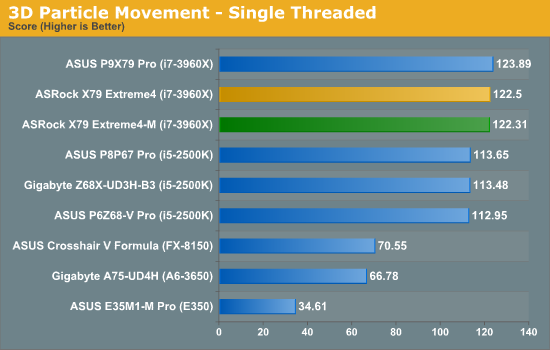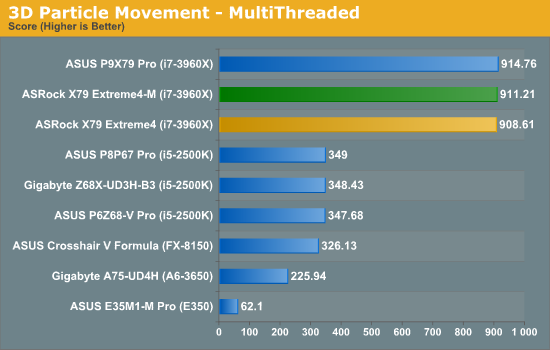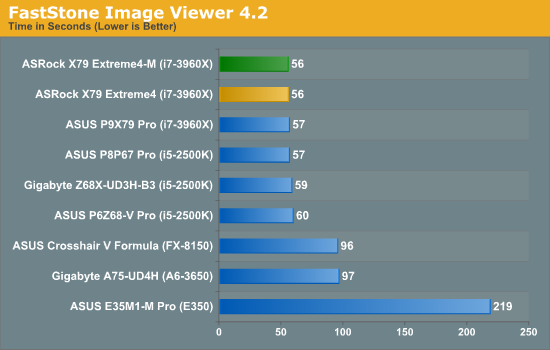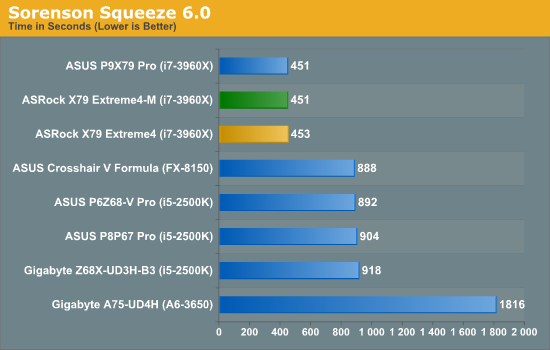ASRock X79 Extreme4-M and X79 Extreme4 Review – Sandy Bridge-E meets mATX
by Ian Cutress on December 9, 2011 12:00 PM EST- Posted in
- Motherboards
- ASRock
- X79
3D Movement Algorithm Test
The algorithms in 3DPM employ both uniform random number generation or normal distribution random number generation, and vary in various amounts of trigonometric operations, conditional statements, generation and rejection, fused operations, etc. The benchmark runs through six algorithms for a specified number of particles and steps, and calculates the speed of each algorithm, then sums them all for a final score. This is an example of a real world situation that a computational scientist may find themselves in, rather than a pure synthetic benchmark. The benchmark is also parallel between particles simulated, and we test the single thread performance as well as the multi-threaded performance.


The extra speed of the i7-3960X shows in both tests, and the ASRock boards are well within 1% of the other X79.
WinRAR x64 3.93 - link
With 64-bit WinRAR, we compress the set of files used in the USB speed tests. WinRAR x64 3.93 attempts to use multithreading when possible.

WinRAR shows better performance under the X79 platform, however neither of the boards was quicker than the ASUS P9X79 Pro.
FastStone Image Viewer 4.2 - link
FastStone Image Viewer is a free piece of software I have been using for quite a few years now. It allows quick viewing of flat images, as well as resizing, changing color depth, adding simple text or simple filters. It also has a bulk image conversion tool, which we use here. The software currently operates only in single-thread mode, which should change in later versions of the software. For this test, we convert a series of 170 files, of various resolutions, dimensions and types (of a total size of 163MB), all to the .gif format of 640x480 dimensions.

Sorenson Squeeze 6.0 - link
Sorenson Squeeze is a professional video encoder, complete with a vast array of options. For this test, we convert 32 HD videos, each a minute long and approximately 42 MB in size, to WMV 512KBps format. Squeeze can encode multiple videos at once, one for each thread.











54 Comments
View All Comments
prophet001 - Friday, December 9, 2011 - link
b/c this is perfect grammar"Also, whats with fascination with older video "
mischlep - Friday, December 9, 2011 - link
Minor typo on recommendations page:(e.g. currently $219 at time of writing, saving £6) Should be "saving $6".
zanon - Friday, December 9, 2011 - link
Interesting review overall. A few comments:Page 6:
You still refer to setup stuff as "BIOS" even though it's clearly (I hope?) UEFI nowadays. Any particular reason for this? Or is it actually still BIOS for real despite clearly saying UEFI on that screen. It's confusing that you use both if you only mean one.
Also on page 6: "With the XFast RAM software, users can shift certain parts of the OS to the RAMdisk, such as the memory pagefile"
What. The entire *point* of a pagefile is that all your physical memory is used up and you're now hitting secondary storage. Reducing your main memory in order to make a RAMdisk that you then...use for memory? Nope nope nope.
Spivonious - Friday, December 9, 2011 - link
Yeah, I don't understand why you'd want the pagefile in RAM instead of just using the RAM.JonnyDough - Friday, December 9, 2011 - link
What he said. Some programs require a pagefile. Allocated memory and a pagefile are not the same.JonnyDough - Friday, December 9, 2011 - link
Also, a pagefile can be dumped/saved on shut down. RAM is cleared.Aisalem - Friday, December 9, 2011 - link
Some of the software will not work properly or will simply crash in some situation if you will have no pagefile enabled. That's why having RAMdisk is very good idea as even if you will have 32GB RAM you still need at least 300MB pagefile on the system to be sure that all software will run proper. Using XFast RAM you simply "cheating" system by creating special partition with only pagefile on it making sure that system is running stable.zanon - Friday, December 9, 2011 - link
Um, no. Windows doesn't have that crappy a VM system, nor does any other modern OS. While some applications may check for the presence of a pagefile if the authors that wrote them were brain dead morons (you should search for other applications in that case), the OS isn't going to start paging anything out of main memory while there is still free or inactive memory available. It'll only start hitting the VM when main memory is consumed. Leave it to the OS. If you want things to go faster once you exceed your maximum physical main memory, get an SSD. Get an SSD anyway, actually.Wardrop - Friday, December 9, 2011 - link
Actually, at work I regularly used up all 8GB of my RAM while running VM's and multi-tasking. When that happened, some programs would spontaneously crash and disappear. Re-enabling the page file (only a small 512MB page file) fixed the problem. This was on Windows 7 x64 by the way. I use to always turn off my page file, but now I always keep a small page file enabled for that reason.JonnyDough - Friday, December 9, 2011 - link
You and Spivonious are so obviously not researched on the matter of using a ramdisk. I suggest you study up before posting, you look like a fool.